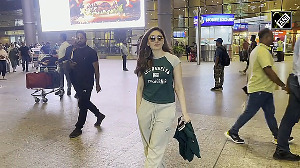Though the BJP is running too close for comfort, populist schemes and support among Muslims may help Mamata Banerjee overcome the challenge, observes Aditi Phadnis.

A trickle is threatening to turn into a flood.
Important leaders in the Trinamool Congress are joining the Bharatiya Janata Party after Suvendu Adhikari's exit.
Worryingly for TMC leader and Chief Minister Mamata Banerjee, six sitting Trinamool MLAs and an MP, on December 19, joined the BJP -- a party which, until recently, had little presence in West Bengal.
With the assembly election barely four or five months away, what should we expect?
Can the BJP dethrone Mamata? This much is true that Mamata's unquestioned popularity in the state has slid several notches, despite many popular programmes.
Gone are the days of valour and bravery shown in the Nandigram and Singur struggle against the Left Front on the back of which the TMC rode to victory.
Also, now almost all anti-Mamata forces are united against her.
Before Adhikari quit the TMC, his otherwise bitter rival, Congress leader Adhir Ranjan Chowdhury said: "When the Nandigram movement was on, I had gone there with relief. I have seen very closely how he led the movement, how much the masses, the poor, the farmers trusted him. I can't lie about that... he did not get his due in the Trinamool."
Chowdhury said he did not know which party Adhikari would join (Adhikari eventually joined the BJP on December 19), but "If something like this keeps happening to someone with the ability, sooner or later there will be a revolt. That revolt will be just."
That was in November. When Adhikari did jump ship, Chowdhury was all praise for him, although he joined another rival, the BJP, to strengthen it.
In short, the Congress is part of an 'anyone but TMC' campaign.
It remains to be seen if the campaign extends to more constructive ways of supporting the BJP.
Even Mamata's most bitter critics concede that many of the programmes devised by her government have reached target groups and translated into results.
When the Covid pandemic was at its height, Bengal was one of the top three states in India to provide work under the Mahatma Gandhi National Rural Employees Guarantees Act to migrants returning home.
The data shows 57.9 million households availed MNREGS between April 1 and September 10 during the current financial year -- the highest since the scheme was launched on February 2, 2006.
This was the badly needed social security net in times of acute distress.
The rollout of the MGNREGA in Bengal was more efficient than many Congress-ruled states.
"There is corruption, a lot of corruption," says Monobina Gupta, social scientist and author of a book on Mamata.
"But there is no doubt as chief minister, Mamata has managed to do as much, if not more, for rural Bengal than the Left Front," Gupta adds.
However, Gupta says, Mamata helmed an incomplete revolution.
At the core of this was the restructuring of the police and the relationship between the government and the law and order forces.
In this, Banerjee has merely mimicked the Left Front.
The state police have been used with impunity to spy and track the movements of political adversaries.
"If Mamata has to decide on a candidate for a local election, before asking her party unit, she will ask the superintendent of police for his views," says a local journalist.
Gupta says this has led to administrative legitimacy to political violence: Something that the BJP has made into a central plank of its political campaign.
One of the central reasons for the TMC's longevity in government and its high vote share is the near-total support of minorities.
Mehebub Sahana, a researcher at the University of Manchester, says West Bengal has been home to the highest percentage of Muslims in India, after the Kashmir valley and Assam.
According to the 2011 Census, the state had 27.1 per cent Muslims, and districts like Murshidabad, Malda, and Uttar Dinajpur have more than 50 per cent Muslim population.
Apart from these three, districts like Birbhum (37.06 per cent), South 24 Parganas (35.57 per cent), Nadia (26.76 per cent), and North 24 Parganas (25.82 per cent), a few blocks of Howrah, Hooghly, and Purba Bardhaman are minority-concentrated.
But Mamata's adoption of visible symbols of Islam in a bid to identify herself with the Muslims -- her hijab, for instance -- also led to a backlash: Again, something that the BJP is capitalising on.
Gupta, who is working on a book on the Hindu Right in Bengal, says the roots of the RSS in Bengal go back in history and are deep but were buried during the Left regime.
The revival nudge was provided by Mamata.
It is hard to say who will form the government after the 2021 election, Gupta says.
But this much is clear: While Mamata's appeal in Bengal endures, the BJP is too close on her heels for comfort.
Feature Presentation: Aslam Hunani/Rediff.com












 © 2025
© 2025